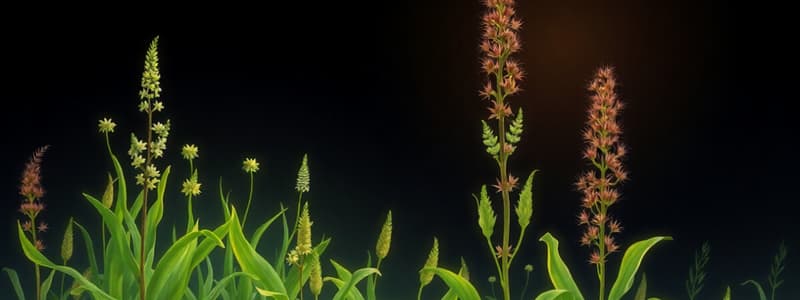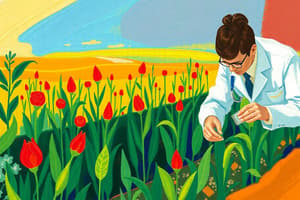Podcast
Questions and Answers
The plumule is named because the tiny leaves inside the seed resemble small ______.
The plumule is named because the tiny leaves inside the seed resemble small ______.
feathers
Grass plumules are protected by a structure called the ______.
Grass plumules are protected by a structure called the ______.
coleoptile
The coleoptile is ______ sensitive, allowing it to grow towards light.
The coleoptile is ______ sensitive, allowing it to grow towards light.
phototropically
Once above ground, the leaves of the plumule emerge through a slit at the ______.
Once above ground, the leaves of the plumule emerge through a slit at the ______.
The embryonic axis consists of the plumule and the ______.
The embryonic axis consists of the plumule and the ______.
The cotyledon serves as a food storage structure known as ______.
The cotyledon serves as a food storage structure known as ______.
Endosperm supplies necessary carbohydrate energy to the germinating ______.
Endosperm supplies necessary carbohydrate energy to the germinating ______.
Cereal grains are botanically classified as a type of ______.
Cereal grains are botanically classified as a type of ______.
Poaceae is pronounced like the highest ranked playing card, the ______.
Poaceae is pronounced like the highest ranked playing card, the ______.
The embryo of a cereal grain consists of three distinct parts: plumule, radicle, and the cotyledon known as the ______.
The embryo of a cereal grain consists of three distinct parts: plumule, radicle, and the cotyledon known as the ______.
The primary root in embryonic form is known as the ______.
The primary root in embryonic form is known as the ______.
A unique sheath-like structure that protects the radicle is called the ______.
A unique sheath-like structure that protects the radicle is called the ______.
The seedling root system is known as the ______ root system.
The seedling root system is known as the ______ root system.
The main root sustaining system in grass species is called the ______ root system.
The main root sustaining system in grass species is called the ______ root system.
The embryonic shoot that develops into above ground structures is termed the ______.
The embryonic shoot that develops into above ground structures is termed the ______.
The small growth point between two pre-formed leaves is known as the shoot apical ______.
The small growth point between two pre-formed leaves is known as the shoot apical ______.
Monocots have ______ cotyledon in the seed.
Monocots have ______ cotyledon in the seed.
Dicots have ______ cotyledons in their seeds.
Dicots have ______ cotyledons in their seeds.
The scutellum in monocots is specialized for absorption of the ______.
The scutellum in monocots is specialized for absorption of the ______.
The two major plant classifications in Saskatchewan's agriculture are ______ and dicots.
The two major plant classifications in Saskatchewan's agriculture are ______ and dicots.
The term ______ refers to the embryonic structure that contains nutritive substances for seedlings.
The term ______ refers to the embryonic structure that contains nutritive substances for seedlings.
In dicotyledonous plants, germination types include ______ and epigeal germination.
In dicotyledonous plants, germination types include ______ and epigeal germination.
The ______ is another name for the seed of a cereal grain.
The ______ is another name for the seed of a cereal grain.
The ______ acts as a growth point in plants, specifically at the tip of stems.
The ______ acts as a growth point in plants, specifically at the tip of stems.
In hypogeal germination, the ______ remain below the soil’s surface supplying stored energy.
In hypogeal germination, the ______ remain below the soil’s surface supplying stored energy.
The stem unit directly below the cotyledons in epigeal germination is called the ______.
The stem unit directly below the cotyledons in epigeal germination is called the ______.
In hypogeal germination, only the ______ rises above the soil surface.
In hypogeal germination, only the ______ rises above the soil surface.
The term 'hypogeal' literally means ______ because the cotyledons remain below the ground.
The term 'hypogeal' literally means ______ because the cotyledons remain below the ground.
During epigeal germination, the above ground cotyledons will initially take on a ______ role.
During epigeal germination, the above ground cotyledons will initially take on a ______ role.
Cereal grains are considered fruits because the outermost wall is derived from the dried ovary wall called the ______.
Cereal grains are considered fruits because the outermost wall is derived from the dried ovary wall called the ______.
The protective outer covering of a seed is referred to as the ______.
The protective outer covering of a seed is referred to as the ______.
The layer just below the seed coat in a cereal grain is known as the ______ layer.
The layer just below the seed coat in a cereal grain is known as the ______ layer.
The aleurone layer, pericarp, and testa together constitute the ______ of the cereal grain.
The aleurone layer, pericarp, and testa together constitute the ______ of the cereal grain.
The germ of a cereal grain is composed of parts primarily involved in ______.
The germ of a cereal grain is composed of parts primarily involved in ______.
Oilseed and pulse crops are examples of ______ plants since their seeds contain two cotyledons.
Oilseed and pulse crops are examples of ______ plants since their seeds contain two cotyledons.
In dicots, the embryonic root is called the ______.
In dicots, the embryonic root is called the ______.
The embryonic shoot in dicots is referred to as the ______.
The embryonic shoot in dicots is referred to as the ______.
Dicot seeds typically lack a distinct ______ because early in development the tissue is absorbed into the cotyledons.
Dicot seeds typically lack a distinct ______ because early in development the tissue is absorbed into the cotyledons.
The ______ surrounds the entire embryo of dicot seeds.
The ______ surrounds the entire embryo of dicot seeds.
A visible scar left on the testa where the seed was attached is called the ______.
A visible scar left on the testa where the seed was attached is called the ______.
A small hole called the ______ permits entry of moisture into the seed at the beginning of germination.
A small hole called the ______ permits entry of moisture into the seed at the beginning of germination.
The first organ to emerge during germination is the ______.
The first organ to emerge during germination is the ______.
In hypogeal germination, the cotyledons remain ______ the soil surface.
In hypogeal germination, the cotyledons remain ______ the soil surface.
Epigeal germination is where the cotyledons are raised ______ the soil surface.
Epigeal germination is where the cotyledons are raised ______ the soil surface.
Hypogeal germination is characteristic of all ______ crops.
Hypogeal germination is characteristic of all ______ crops.
Flashcards
Monocotyledon
Monocotyledon
A type of plant with one embryonic seed leaf (cotyledon).
Dicotyledon
Dicotyledon
A type of plant with two embryonic seed leaves (cotyledons).
Cotyledon
Cotyledon
An embryonic seed leaf that provides nourishment to the developing seedling.
Scutellum
Scutellum
Signup and view all the flashcards
Endosperm
Endosperm
Signup and view all the flashcards
Embryo
Embryo
Signup and view all the flashcards
Monocot embryo
Monocot embryo
Signup and view all the flashcards
Dicot embryo
Dicot embryo
Signup and view all the flashcards
Poaceae pronunciation
Poaceae pronunciation
Signup and view all the flashcards
Monocot Embryo Parts
Monocot Embryo Parts
Signup and view all the flashcards
Radicle
Radicle
Signup and view all the flashcards
Coleorhiza
Coleorhiza
Signup and view all the flashcards
Seminal Root System
Seminal Root System
Signup and view all the flashcards
Secondary Adventitious Root System
Secondary Adventitious Root System
Signup and view all the flashcards
Plumule definition
Plumule definition
Signup and view all the flashcards
Shoot Apical Meristem (SAM)
Shoot Apical Meristem (SAM)
Signup and view all the flashcards
Plumule
Plumule
Signup and view all the flashcards
Coleoptile
Coleoptile
Signup and view all the flashcards
Phototropism
Phototropism
Signup and view all the flashcards
Cotyledon/Scutellum
Cotyledon/Scutellum
Signup and view all the flashcards
Embryonic axis
Embryonic axis
Signup and view all the flashcards
Cereal grain
Cereal grain
Signup and view all the flashcards
Seedling independence
Seedling independence
Signup and view all the flashcards
Hypogeal Germination
Hypogeal Germination
Signup and view all the flashcards
Epicotyl
Epicotyl
Signup and view all the flashcards
Epigeal Germination
Epigeal Germination
Signup and view all the flashcards
Hypocotyl
Hypocotyl
Signup and view all the flashcards
Dicot Seed Endosperm
Dicot Seed Endosperm
Signup and view all the flashcards
Testa (Seed Coat)
Testa (Seed Coat)
Signup and view all the flashcards
Hilum
Hilum
Signup and view all the flashcards
Micropyle
Micropyle
Signup and view all the flashcards
Cereal Grain Parts
Cereal Grain Parts
Signup and view all the flashcards
Aleurone Layer Function
Aleurone Layer Function
Signup and view all the flashcards
Bran Composition
Bran Composition
Signup and view all the flashcards
Germ Composition
Germ Composition
Signup and view all the flashcards
Dicot Seeds
Dicot Seeds
Signup and view all the flashcards
Dicot Embryo Parts
Dicot Embryo Parts
Signup and view all the flashcards
Cotyledon Function
Cotyledon Function
Signup and view all the flashcards
Examples of Dicots
Examples of Dicots
Signup and view all the flashcards
Study Notes
Crop Emergence & Development
- Learning Objectives:
- Distinguish between monocot and dicot embryos
- Describe differences between monocots and dicots
- List and describe two dicot germination types
- Identify two monocot internode elongation types
Key Terms and Concepts
- Aleirone layer: Protein-rich layer surrounding endosperm
- Bran: Outer layers of the cereal grain (pericarp, testa, and aleurone)
- Caryopsis: Cereal grain (a fruit)
- Coleoptile: Sheath protecting the plumule
- Coleorhiza: Sheath protecting the radicle
- Cotyledon: Embryonic seed leaf
- Dicot: Plants with two cotyledons
- Embryo: Early stage of plant development
- Embryonic axis: The central column formed by the plumule and radicle
- Endosperm: Food storage tissue in the seed
- Epicotyl: The area of the stem above the cotyledons
- Epigeal germination: Cotyledons are raised above the soil
- Fruit: Structure derived from the ripened ovary wall
- Germ: Embryo of the cereal grain
- Hilum: Scar where the seed was attached to the fruit
- Hypocotyl: Area of stem below the cotyledons
- Hypogeal germination: Cotyledons remain below the soil surface
- Monocot: Plants with one cotyledon
- Mesocarp/Pericarp: Outermost wall of the fruit
- Micropyle: Small hole in the seed coat
- Plumule: Embryonic shoot
- Radicle: Embryonic root
- Scutellum: Specialized cotyledon in monocots
- Seed: Structure containing the embryo
- Testa: Seed coat
Introduction to Monocotyledons and Dicotyledons
- Monocots and dicots are major plant classifications
- The number of cotyledons is the primary difference
- Monocots have one cotyledon (scutellum)
- Dicots have two cotyledons
Monocots (Cereals)
- Cereal grains are members of the Poaceae (grass) family
- The scientific name of the grass family is Poaceae.
The Monocot (Cereal) Embryo
- The embryo includes the plumule, radicle, and scutellum
- The radicle is protected by the coleorhiza
- The plumule has pre-formed leaves and the SAM (shoot apical meristem)
- The coleoptile protects the plumule
- The plumule is phototropic (grows towards light)
- The cotyledon (scutellum) stores food for germination
The Dicot Embryo
- Dicot embryos have a radicle, plumule, and two cotyledons
- The cotyledons are responsible for food storage
- Testa (seed coat) surrounds the embryo
- Hilum is the scar where the seed was attached to the fruit
Germination and Emergence
- Germination involves seedling development
- Radicle emerges first, followed by the coleoptile and plumule
- Seedling depth influences stem internode elongation
- Secondary adventitious roots develop from the coleoptilar node
- Two germination types: hypogeal and epigeal
Hypogeal Germination
- Cotyledons remain below the soil
- Epicotyl emerges from between the cotyledons
- Plumule is protected by the cotyledons
- Only true leaves are above the ground
Epigeal Germination
- Cotyledons are raised above the soil
- Hypocotyl elongates, pulling the cotyledons up
- Plumule is enclosed between the cotyledons until emerging above the soil
Studying That Suits You
Use AI to generate personalized quizzes and flashcards to suit your learning preferences.




